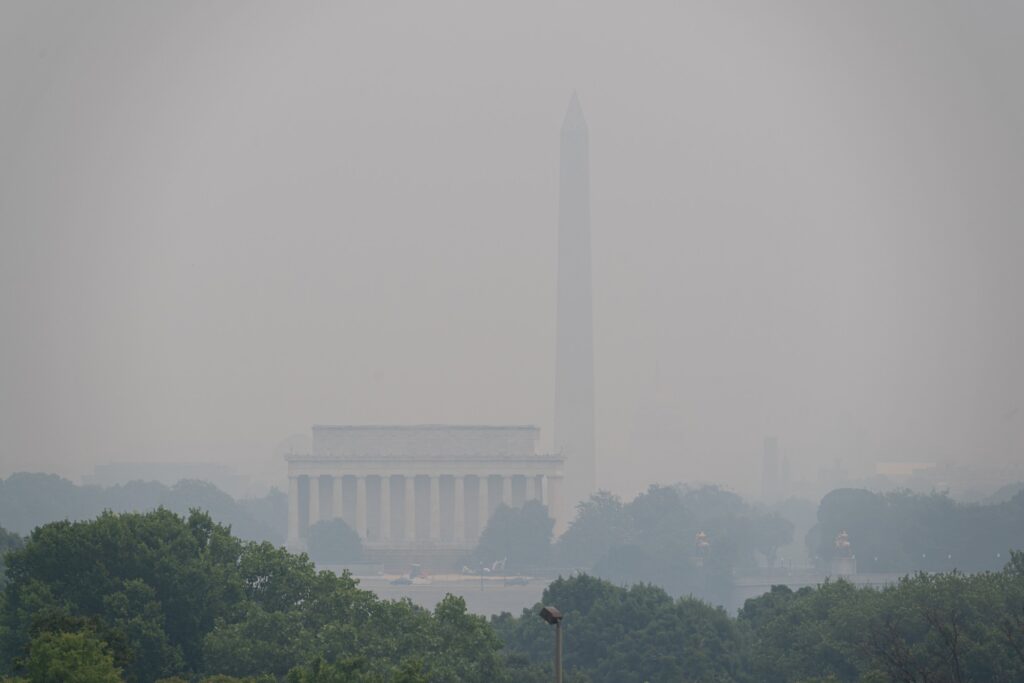“Why can’t I bike to school today?” my son asked at breakfast one morning in June. Air pollution from the wildfires in Canada had drifted down to D.C., causing schools to keep children inside for a couple days. We talked about what pollution does to your lungs, the ways that people design and build buildings to clean air that comes in from outside as well as the air already within a building. He asked insightful questions that stretched my ability to speak to building science in simple terms, and the inequity inherent in the impacts of these events.
While our friends on the West Coast have adapted to increasing wildfires, this was a new experience for many in the Northeast. There was a flurry of life adjustments, public education (that missed the mark in many ways), and different risks to calculate. This month, conversations with my friends and family focused more on building performance than normal, and made me think about the collective wake-up call screaming from the headlines. Did you see it too?
Deep questions of accountability
Who is ready to face, and take responsibility for, current and future problems when it comes to our built environment? Arizona limited construction in the Phoenix area because of lack of water, after years of planning and calls for action. Major insurance companies pulled out of California due to questions and disputes around who bears the cost of increasingly complex risk factors when buildings are damaged or destroyed by fire or other extreme weather. Is it building owners? What happens when insurance companies can’t foot the bill for the risk that they took on? Should the government be the backstop—if so, at what level?
International Refugee Day drew calls for attention to climate migration, which of course has impacts on our communities. We are all at risk of having to uproot our lives because of the increased man-made extreme weather. Wealth and resources can shield people to a certain extent from droughts and heat, but disasters like wildfires do not discriminate. So who is responsible when buildings and communities become unlivable and people need to leave? Do solutions lie in existing structures like vacant office buildings due to the pandemic-era shift to remote work? What regions have adequate building stock and infrastructure to support the inevitable influx of climate refugees?
Because of the complexity of these issues, it’s tempting to throw our hands up and say “It’s above my pay grade” or relegate solutions to future generations. But right now—not in 2050 or when warming has gone above 1.5°—so many of our neighbors are struggling to access healthy, resilient, and low pollution housing. Businesses in the building industry are struggling to fund and resource major climate and efficiency projects. Government leaders are struggling to take the necessary immediate actions and craft long-term plans to strengthen their communities.
The time has come for all of us to give it what we’ve got. What do you have to contribute based on your years of working on building improvements? What solutions have you learned from your community? What will it take for us to put our collective years of experience to the issues of climate mitigation and adaptation so we can address these questions together?
Taking action
This week, a new acquaintance said to me “We are in a moment in history where the old ways of operating no longer make sense.” The combination of physical and financial questions, not to mention the human and societal challenges, means that we are facing a new global reality that has a big impact on our ability to provide safe, healthy, climate-appropriate buildings for all. Here are some steps we all need to take together, no matter what our role, expertise, or perspective.
Build solutions with people who bring a very different perspective to the problem than you do. My kids ask great questions because they bring a totally fresh perspective to many topics. It’s one of the reasons that cross-sector, cross-industry collaboration on program and policy design can have such powerful impacts: you can see how a decision in design will play out from multiple angles and for multiple stakeholders. BIPOC and low-income community representatives who are experiencing the first and worst effects of the climate crisis have a crucial perspective that building decarbonization specialists often lack, and thus must be at the table to build solutions. Stepping back to look at this bigger picture at the same time as you work to build a solution to a specific problem can help us find the systemic levers for change.
Show what is working…and what is not. What are you doing that is working well, and who are you sharing that with? Particularly if you are someone who is working on specific buildings. For example, if you have a financial case for resilient, healthy, low pollution development and can show solutions that have health, emissions reductions, resilience, and financial benefits…share it! If you are a government leader, what are the results and impacts of the policies that you are creating or implementing? If you are a community leader, what have been the most effective interventions with persistent benefits? And if a solution went completely off the rails—share those stories with the world. Being transparent about an issue you faced could save another business or government from implementing harmful practices.
Look within to lead. This may be the most important! Tackling complex, multi-faceted challenges is taxing work, and requires that we do inner work as well. What are you doing to be the best leader that you can be? Are you showing up with creativity and curiosity? Are you willing to challenge your biases and think beyond the way that things “have always worked” to imagine what might be? What alliances can you build and resources can you call on to be as effective as you can be?
Reducing the impacts of climate change on our health and livelihoods means working to eliminate emissions, adapting our physical buildings, and creating new financial practices. It’s a task that requires all of us to consistently take a step back to look at the bigger picture and see where something no longer serves us or meets the moment. I’m so grateful for everyone who has met me in that space this month and sparked some new inklings of solutions.
This column originally appeared as a blog on the IMT (Institute for Market Transformation) website.
 Lotte Schlegel is the Executive Director of the Institute for Market Transformation (IMT), a national nonprofit organization that is laser-focused on increasing energy efficiency in buildings to save money, drive economic growth, reduce harmful pollution, and tackle climate change. Under her guidance, IMT is a trailblazer in the energy efficiency field, recognized across the globe for accelerating investment in energy-efficient buildings through hands-on guidance, technical and market research, policy and program development, and promotion of best practices. As IMT’s Executive Director, Lotte guides the organization’s growth and leads the implementation of its multi-year strategic plan. She oversees internal operating systems and processes with an eye on both big-picture vision and tactical execution.
Lotte Schlegel is the Executive Director of the Institute for Market Transformation (IMT), a national nonprofit organization that is laser-focused on increasing energy efficiency in buildings to save money, drive economic growth, reduce harmful pollution, and tackle climate change. Under her guidance, IMT is a trailblazer in the energy efficiency field, recognized across the globe for accelerating investment in energy-efficient buildings through hands-on guidance, technical and market research, policy and program development, and promotion of best practices. As IMT’s Executive Director, Lotte guides the organization’s growth and leads the implementation of its multi-year strategic plan. She oversees internal operating systems and processes with an eye on both big-picture vision and tactical execution.





